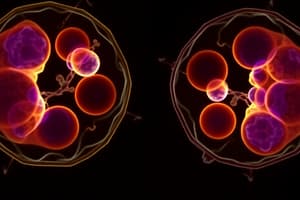Podcast
Questions and Answers
What is the primary role of genes within chromosomes?
What is the primary role of genes within chromosomes?
- To enhance replication of chromosomes
- To protect the DNA from mutations
- To determine the size and shape of the chromosome
- To serve as units of information about heritable traits (correct)
How many alleles do individuals inherit for each gene?
How many alleles do individuals inherit for each gene?
- Four, two from each parent
- Three, one from each parent and a third from mutations
- One from the sperm
- Two, one from the egg and one from the sperm (correct)
What characterizes homologous chromosomes?
What characterizes homologous chromosomes?
- They have the same size, shape, and genes, but possibly different alleles (correct)
- They can be different lengths but share the same genes
- They always have identical alleles
- They are found only in diploid organisms
What is a nucleosome composed of?
What is a nucleosome composed of?
What determines the expression of a trait in an organism?
What determines the expression of a trait in an organism?
What is the primary purpose of mitosis in somatic cells?
What is the primary purpose of mitosis in somatic cells?
Which phase of the cell cycle is the longest?
Which phase of the cell cycle is the longest?
During which mitotic phase do chromosomes align in the middle of the cell?
During which mitotic phase do chromosomes align in the middle of the cell?
What happens to the chromosomes during Anaphase?
What happens to the chromosomes during Anaphase?
What is formed during Telophase?
What is formed during Telophase?
Which structure helps organize spindle fibers during mitosis in animal cells?
Which structure helps organize spindle fibers during mitosis in animal cells?
What is the final stage of the cell cycle called?
What is the final stage of the cell cycle called?
Which term refers to the duplicated copies of a chromosome during mitosis?
Which term refers to the duplicated copies of a chromosome during mitosis?
What is the primary function of chromosomes in a cell?
What is the primary function of chromosomes in a cell?
Which statement correctly describes the difference between prokaryotic and eukaryotic cells?
Which statement correctly describes the difference between prokaryotic and eukaryotic cells?
What is the result of a chromosome being duplicated during interphase?
What is the result of a chromosome being duplicated during interphase?
How many total chromosomes do human cells have?
How many total chromosomes do human cells have?
In which zone does the formation of a cell plate primarily occur?
In which zone does the formation of a cell plate primarily occur?
What are the two forms of DNA found in cells?
What are the two forms of DNA found in cells?
What is the role of histone proteins in relation to DNA?
What is the role of histone proteins in relation to DNA?
What is the structure of DNA commonly described as?
What is the structure of DNA commonly described as?
Flashcards are hidden until you start studying
Study Notes
Mitosis Overview
- Mitosis is essential for growth and repair of tissues.
- Occurs in all somatic (body) cells resulting in two genetically identical daughter cells.
Cell Cycle
- The cell cycle consists of interphase and the mitotic phase.
- Interphase includes three stages: G1, S, and G2.
Interphase (G1, S, G2)
- Longest stage of the cell cycle focusing on preparation for division.
- Cells grow and duplicate organelles.
- DNA is replicated, forming "doubled chromosomes" in an X shape.
Stages of Mitosis
- Mitosis involves four distinct stages: Prophase, Metaphase, Anaphase, and Telophase.
Prophase
- Chromosomes become visible as the nuclear membrane dissolves.
- Chromosomes are released into the cytoplasm.
Metaphase
- Chromosomes align in the cell's center.
- Replicated chromosomes are connected by centromeres; each copy is a chromatid.
Anaphase
- Spindle fibers pull chromatids to opposite ends of the cell.
- Each new cell receives a complete set of chromosomes.
Telophase
- Chromosomes reach opposite ends; new nuclear membranes form around each set of chromosomes.
- The cell is not yet divided.
Cytokinesis
- Final stage of the cell cycle where remaining contents are divided.
- In animal cells, microfilaments form a cleavage furrow; in plant cells, carbohydrate vesicles form a cell plate.
- Results in two identical cells.
Prokaryotic vs Eukaryotic Cells
- Prokaryotic cells: No nucleus, membrane-bound organelles, divide without mitosis.
- Eukaryotic cells: Have a nucleus, organized DNA, divide by mitosis.
DNA and Chromosomes
- DNA (deoxyribonucleic acid) is a biological molecule composed of nucleotides.
- Double-stranded structure forms a double helix.
- Each human cell contains approximately 3 meters of DNA packaged within the nucleus.
Chromosome Structure
- Humans have 46 chromosomes (23 pairs); all must be duplicated during interphase.
- Chromosomes ensure accurate DNA distribution during mitosis.
Genes and Alleles
- Genes are segments of DNA that code for heritable traits.
- Each gene can exist in different versions known as alleles.
- Alleles inherited from each parent determine expressed traits.
Chromosomal Characteristics
- Homologous chromosomes are similar in size, shape, and gene composition, but may carry different alleles.
- Each chromosome pair consists of one from the mother (egg) and one from the father (sperm).
Studying That Suits You
Use AI to generate personalized quizzes and flashcards to suit your learning preferences.



